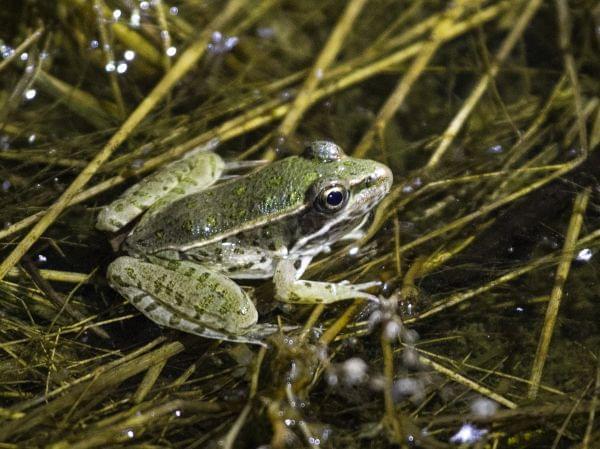Nighttime is the right time to count frogs and toads

A southern leopard frog at the Middle Fork River Forest Preserve. Rob Kanter
If you were to base a movie character on Dave Stone, you’d probably have to tone down his enthusiasm for science and teaching—and that’s saying something, given that he’ll begin his thirty-second year in the classroom at Uni High this fall. This was my thought, anyway, as we headed out of Urbana in his Prius one early July evening, on our way to the Middle Fork River Forest Preserve in the northeast corner of Champaign County. This will be so cool,” he kept saying. “We’re going to get you set up for some great frog pictures.”
Although Stone and I were both excited about the frog pictures we might get, our primary mission that evening was to gather data about the numbers and kinds of frogs present at two of the Preserve’s wetlands.
These are Stone’s designated sites in a frog and toad monitoring program coordinated by the Champaign County Forest Preserve District. The program relies on citizen-scientists to gather information about which species of frogs and toads inhabit its five preserves, and in what numbers, along with information about how they are distributed across the landscape.
Why? As wildlife, amphibians are of interest for their own sake, and around the world many of them have been declining for decades. Locally, they play important roles in food webs, as they eat (insects and other small invertebrates, mostly) and are eaten (by a wide variety of other animals, from herons to raccoons to largemouth bass).
Amphibians also serve as indicators of environmental health, since they tolerate varying degrees of degradation in their habitat. Some highly tolerant species can breed in ditches along roadsides and railroad tracks, while others require better preserved or restored natural settings to thrive.
If you’re with unfamiliar frog and toad surveys, you may wonder why we were headed out in the evening, rather than earlier in the day; it’s because to count frogs and toads you use your ears rather than your eyes. Think about it—these critters are generally small and very well camouflaged, and they often occupy habitats that are inaccessible to people. To count all of the frogs and toads you see in a walk around a marsh is normally to count very few of either.
But in spring and summer, frogs and toads gather at bodies of water to breed. And there, males advertise themselves with calls distinct to their species, in a chorus of peeps, boinks, chirps, and trills that really heats up only after darkness has fallen.
So we surveyed by standing still and listening for about a minute, once at each spot while there was still some light to see by, just to get a sense of what was out there, and once about half an hour after it was fully dark to make our official count. Stone also made an audio recording of our official observations so he could confirm what we were hearing later, at home. What we heard were four species of frogs: grey treefrogs, cricket frogs, green frogs, and bullfrogs, pretty much what would be expected, given the setting and time of year.
The month of July marks the end of the frog and toad survey season, and the species we heard represent the tail end of a procession that began in March, with spring peepers and western chorus frogs, and continued in April, May and June with the addition of three more species.
Oh, and we got some frog pictures, too, although I felt like the results of my efforts didn’t do justice to the trouble Stone took to get me set up. I definitely need to get out for more practice at this in the future.

